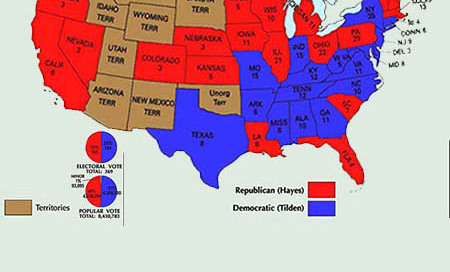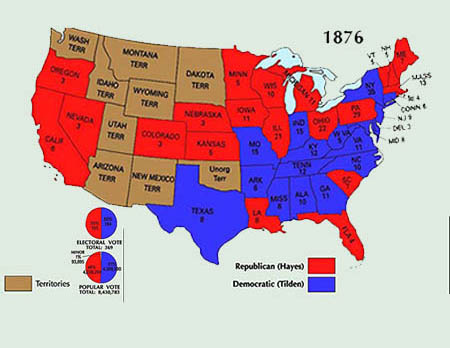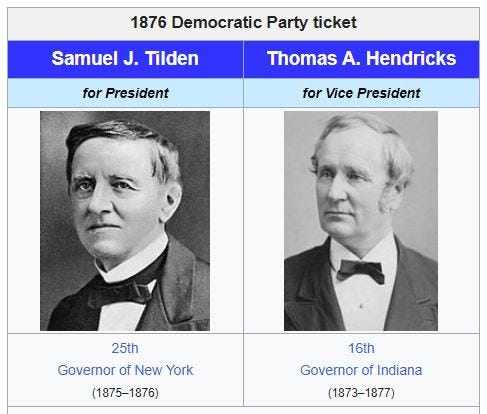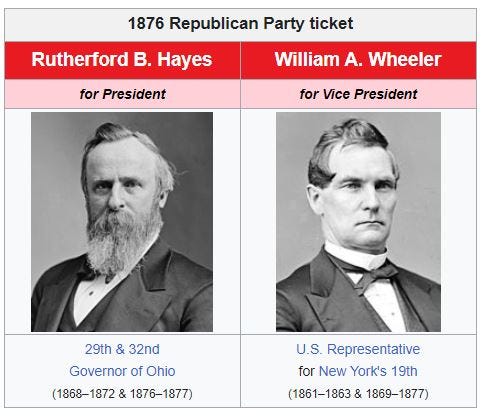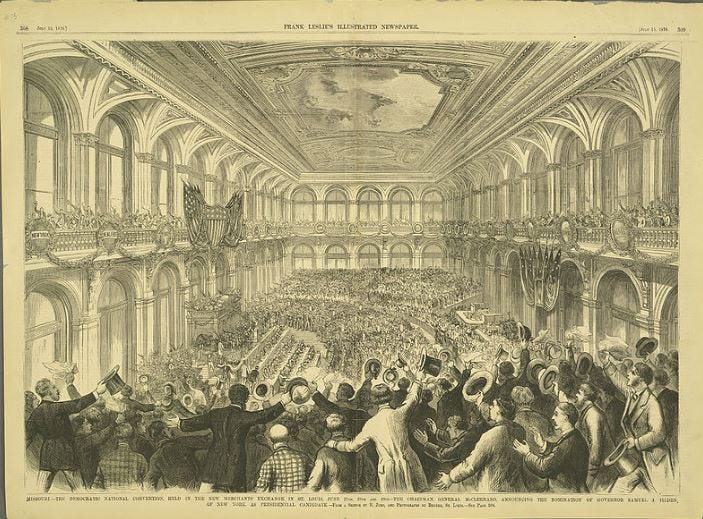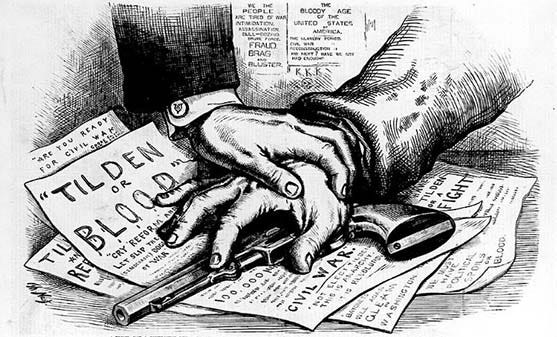The Great American Presidential Bamboozle…of 1876
You think our current elections are uniquely quarrelsome. It’s happened before.
A bloody resistance transpired a dozen years after the Civil War, after two corrupt Ulysses S. Grant administrations, the open wounds of the war and the predatory “Reconstruction” acts, and the ruthless rules the governance the North had been setting finally became intractable.
The North was tired of war and weary of the continued conflict they were causing finally came to a head with the Presidential Election of 1876. It was then the Republican Rutherford B. Hayes and Democrat Samuel Tilden squared’
We think our volatile, American political elections, with sides mired in intractable partisanship is unique, but it’s happened before each side claiming voter fraud and manipulation.
Twice since 2000 the candidate with the most votes lost. Al Gore most egregiously was denied his election by a partisan Supreme Court and a Republican Florida Attorney General, and of course Hillary Clinton, who garnered three million more votes than Donald Trump and lost in the Electoral College.
Then Donald got his come ‘uppance and screamed to high heaven about a fraudulent election. The partisan divide seems greater than ever, but the politics of 1876 and its Presidential election gives our elections a run for their money.
Arguably, there was a more troubling time in America's history just a twelve years after the Civil War. The armies may have gone home, but the political battle between the North and South continued unabated.
The Presidential contest between Rutherford Hayes and Samuel Tilden, wherein Republican Rutherford B. Hayes stole the election from Samuel Tilden, stands out as one of the greatest fraudulent battles in American presidential history. I’ll bet one-in-a-hundred Americans even know who these two are let alone the history of their election.
In the mid-1800s the Republican and Democrat parties were philosophically opposite of what they are today. The North, primarily industrial and dominated by Republicans, were the Federalists seeking a centralized union whereby they could benefit from tariffs and mercantile taxes extracted from the South.
The Democrats were a party of the South financed and dominated by Southern slave owners. It was predominately agrarian economy, dependent on the free labor of slaves to produce one crop-- cotton, which was being threatened by an expanding global marketplace.
As the nation grew rapidly there was political upheaval caused by sharp disagreement on the fundamental purpose over States Rights vs. the power of the federal government.
With no Lincoln to temper the fierce Northern retribution that followed, The North took severe advantage and the predatory “Reconstruction Acts”, and the ruthless rules the governance the North had been imposing in the South finally became intractable.
In reality, the North was tired of war and weary of the continued conflict they were causing. Everything finally came to a head with the Presidential Election of 1876. It was then the Republican Rutherford B. Hayes and Democrat Samuel Tilden squared off.
Samuel Jones Tilden was the 25th Governor of New York and the Tilden was a Bourbon Democrat who worked closely with the New York City business community and led the fight against the corruption of Tammany Hall.
Bourbon Democrats promoted of a form of laissez-faire capitalism, which included opposition to the high-tariff protectionism that the Republicans advocating as well as fiscal discipline.
Sounds like the current day Republicans used to be. But they heavily They represented business interests as they do today, generally supporting the goals of banking and railroads.
They opposed imperialism and U.S. overseas expansion, fought for the gold standard, and were strong supporters of reform movements such as the Civil Service Reform and opponents of the corrupt city bosses and led the fight against the Tweed Ring.
His opponent, Samuel Rutherford Hayes, an attorney in Ohio, was city solicitor of Cincinnati from 1858 to 1861. When the Civil War began, he left to join the Union Army as an officer.
He was wounded five times and earned a reputation for bravery in combat and was promoted to brevet major general. After the war, he served in the Congress from 1865 to 1867 as a Republican. He left Congress to run for Governor of Ohio and was elected three times.
In 1876, he was elected president in one of the most contentious elections in national history. He lost the official popular vote to Democrat Samuel J. Tilden, but he won an intensely disputed electoral college vote after a Congressional commission awarded him twenty contested electoral votes.
Hayes went to bed on election night convinced he would soon be making a concession speech complaining that the election was fraudulent (sound familiar). But he woke up to learn that he had won the Pacific Slope and would need to claim the southern states of South Carolina, Florida, and Louisiana in order to ensure the 185 electoral votes, needed at that time, for a comeback win.
The election boards in those three states, citing intimidation of black voters, voided Democratic votes and declared Hayes the winner. But then Hayes lost Oregon when it emerged that one of the state’s Republican electors held a government job and could not cast his vote for Hayes. The Democratic governor certified a new Democratic elector.
A major fight broke out. Senate leadership was inundated with requests from Republicans to decide which votes to count, while Democrats wanted a joint session of Congress to determine the winner.
Interior of the Merchants Exchange Building of St. Louis, Missouri, during the announcement of Samuel J. Tilden as the Democratic presidential nominee
Ultimately, the two sides forged a compromise passing the Electoral Commission Act in January 1877. The act established a commission of five senators, five congressmen, and five Supreme Court justices who would decide what votes to count.
During intense closed-door meetings, Democratic leaders agreed reluctantly to accept Hayes as President in return for the withdrawal of federal troops from the last two Southern states that were still occupied: South Carolina and Louisiana.
Republican leaders in return agreed on a number of handouts and entitlements, including federal subsidies for a transcontinental railroad line through the South.
Although some of the promises were not kept, particularly the railroad proposal, that was enough for the time being to avert a dangerous standoff. Voting along party lines in a series of votes in February Hayes was awarded the disputed states.
Not so fast! The outraged, Democrat-controlled House filibustered the results until March 2, when Hayes was finally awarded the disputed states, just days before the inauguration. These votes gave Hayes a 185-184 advantage in the Electoral College and the presidency.
"A truce – not a compromise, but a chance for high-toned gentlemen to retire gracefully from their very civil declarations of war." By Thomas Nast in Harper's Weekly, 1877 Feb 17, p. 132.
Hayes was elected with about 250,000 fewer popular votes than Tilden and was sneeringly referred to as “Rutherfraud” and “His Fraudulency” by angry Democrats.
However, there was no riot in front of Congress to protest and the almost overthrow of the American government, where people were injured and killed. That was left to our 2020 Presidential election. That’s electoral progress, I guess. Can’t wait to see what happens to 2024
Electorl Map United States Geological Survey - https://nationalmap.gov/small_scale/printable/elections.html


